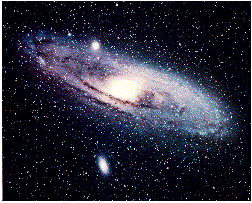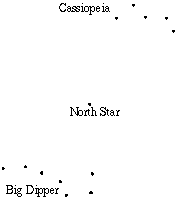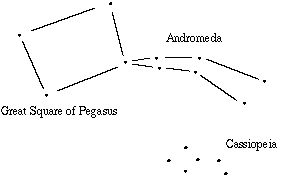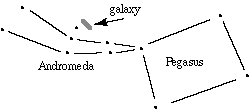

Observing the Andromeda Galaxy
The Andromeda Galaxy is the most distant object you can see with your naked eyes, two million light years away. It is visible as a dim, fuzzy star from a dark sky site. With binoculars you can clearly see the elliptical shape of the galaxy.
The galaxy passes high overhead during the fall of the Northern Temperate Zone of the Earth, crossing the top of the sky about midnight in mid October, and two hours earlier each month thereafter. It is fully visible in early evening, rising in the east in September, until it begins to set in the west into the evening twilight in February.
To find the galaxy, locate the North Star, and then locate the constellation of Cassiopeia. Cassiopeia is a W-shaped circumpolar constellation approximately opposite the Big Dipper across the North star.

If you add one more star to the "W" of Cassiopeia, you get a chair shape with an uncomfortable looking back. The chair may be upside down in the sky, but look in the direction away from the bottom of the chair in the sky (not necessarily down towards the horizon) to locate the Great Square of Pegasus.

Constellations are like state maps; every star is in one constellation or another, but a few stars are (unofficially) shared between constellations . The star of the Great Square of Pegasus closest to Cassiopeia, Alpheratz, is shared between Andromeda and Pegasus. This star is the head of Andromeda. Her feet open out in two curved lines (like a girl's skirt) extending back under Cassiopeia. (Cassiopeia was Andromeda's mother.)

To find the galaxy start at Andromeda's head and count three stars along the lower curved line. Then, starting from this star, count across three stars. The galaxy is just above and to the right of this third star. As noted above, the galaxy looks like a dim, fuzzy star to the naked eye, and like a small elliptical cloud in binoculars. The diagram below show the situation as Pegasus and Andromeda rise in the east.

Through a telescope the Andromeda Galaxy looks quite diffuse. Use your lowest power; the full extent of the galaxy is huge -- five times as large as the full moon. You won't be able to get the whole thing in the field of view; you have to move the telescope around. With a 8 or 12" telescope you can see the nucleus and the outer disk, the two companion galaxies, and make out the dark lanes below and to the left of the nucleus (see picture above).
This is our great sister galaxy, 100,000 light years in diameter, with perhaps 400 billion stars. It hard to believe so many stars could look so dim. As this distance not a single star is visible to the eye, even in the largest telescopes, but a large telescope can photograph individual bright stars. In the twenties, Hubble obtained photographs through the new 100" Mt. Wilson telescope of individual Cepheid variables in the galaxy, and was able to determine that the galaxy is far beyond our galaxy, ending a long controversy about what the "spiral nebula" really were. But not even the great telescopes can photograph a small star like the Sun at this distance.
While you have your telescope pointed in this area of the sky, try the last star of Andromeda on the lower curved line, furtherest from Cassiopeia, (Gamma Andromedae) at moderate power. This is a pretty colored double.
Back to observational page.